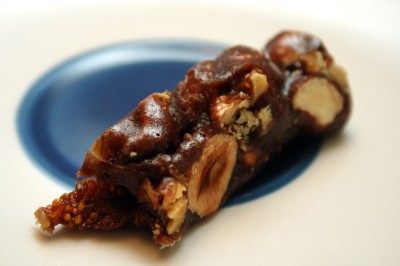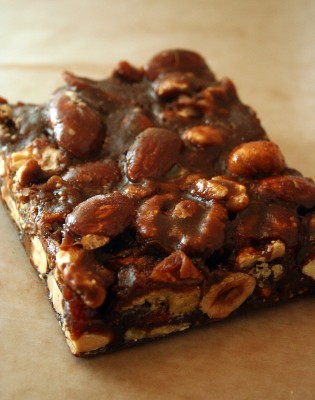At this time of year, the dirtiest word you can utter is fruitcake (foodwise, at least). You could be describing the most delicious thing in the world, but as soon as you mention dried fruit, nuts and spices, people associate it with fruitcake and run the other direction.
Fruitcake is lovingly referred to as “the gift that keeps giving,” since every loaf you receive looks suspiciously like the one you gave away last year. If you’re tired of cakes with neon-colored fruit pieces, here’s an alternative.
Panforte is an Italian confection with plump, dried figs; honey and whole nuts. Wait, don’t leave! It’s not fruitcake. It’s sticky and chewy, like the topping on pecan bars. Think of it as healthy fruit fudge, since there’s no butter, cream or oil. When I made these as gifts this year, I was careful not to refer to it as fruitcake. It worked. One of the recipients didn’t even get to bring it home. He took it to a party, and his friend’s mom ate it all.
Panforte with coffee is a morning treat, and it becomes an afternoon pick-me-up when paired with tea. It also goes well with wine and cheese (or so I’ve heard), but I’m not a savory person. The version below is Alice Medrich’s panforte nero (black strong bread), which gets an extra kick from cocoa and spices. If you don’t have all the spices and nuts, use whatever you have. Walnuts work well, and I substituted a scant teaspoon of whole, slightly crushed cumin for the fennel.
To find out more about dessert pioneer Alice Medrich (they don’t call her the First Lady of Chocolate for nothing), check out the “Minimalist’s Dessert [2]” interview, which I did for Chow.com. As another fruitcake alternative, try the date and walnut bars from Alice Medrich’s Cookies and Brownies [3]. Just tell the fruitcake-phobes that they’re “friendship bars [4].”

Panforte Nero
Adapted from Alice Medrich’s Pure Dessert [5]
Serves 12-16
1 cup (4.75 ounces) hazelnuts, toasted and loose skins rubbed off
3/4 cup (3.75 ounces) whole unblanched almonds, toasted
2/3 cup (3 ounces) all-purpose flour
2 tablespoons natural (nonalkalized) cocoa powder
2 1/4 teaspoons slightly crushed fennel seeds
Slightly rounded 1/2 teaspoon ground cinnamon
Slightly rounded 1/8 teaspoon ground cloves
Slightly rounded 1/4 teaspoon finely ground white pepper
Slightly rounded 1/4 teaspoon ground ginger
Slightly rounded 1/4 teaspoon finely crushed coriander seeds
Slightly rounded 1/4 teaspoon freshly grated nutmeg
grated zest of 1 orange, preferably from an organic or unsprayed fruit
8 ounces dried Mission or other figs, tough stems cut off and sliced about 1/4-inch thick
2/3 cup honey
2/3 cup sugar
Powdered sugar or cocoa powder for dusting (optional)
Equipment: An 8-inch round cake pan
Position a rack in the lower third of the oven and preheat to 300° F. Grease the pan and line the bottom with parchment paper. Line the sides with a 2-inch wide band of parchment. Liberally grease the parchment all over.
In a large bowl, mix the nuts, flour, cocoa, spices, orange zest and figs.
In a 3- to 4-quart saucepan, bring the honey and sugar to a full boil. Boil for 15 seconds. Take off the heat and pour into the dry ingredients. Mix thoroughly, and quickly, before the syrup hardens.
Scrape the mixture into the pan and spread it evenly. Bake until it bubbles in the center and the edges, 40 to 45 minutes. Cool the panforte in the pan on a rack.
Invert the panforte onto a plate. Peel off the parchment and turn the panforte right side up. If desired, dust the top with powdered sugar or cocoa powder. Serve in thin slices.
Panforte keeps forever, well wrapped, at room temperature. But I don’t think it will last that long.
